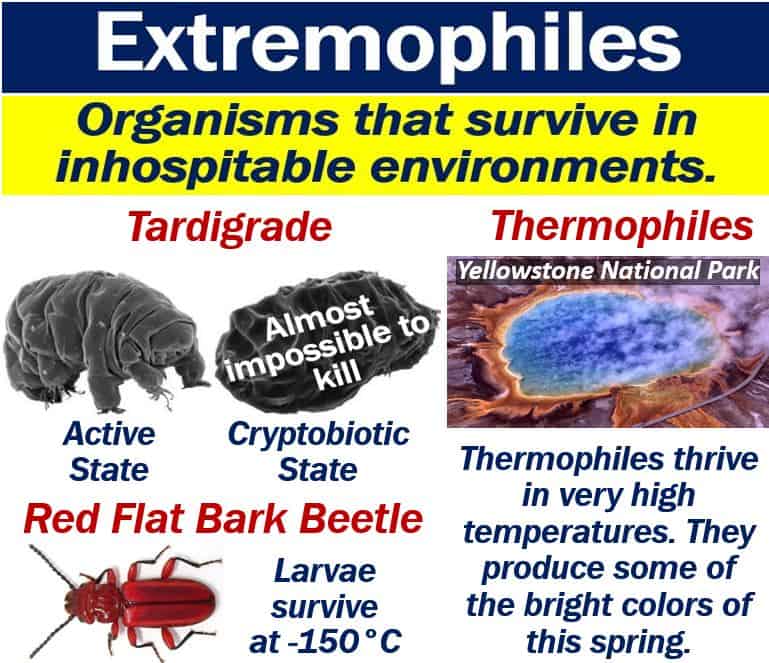What are extremophiles? Definition and examples
Extremophiles are living beings or organisms that can survive in extreme environments, i.e., inhospitable environments. They can also reproduce, i.e., thrive in extreme environments. They exist in geochemically or physically extreme conditions. Extremophiles can live and reproduce in environments that would kill most other living beings.
Recent research suggests that extremophiles are not just survivors but could be biotechnological goldmines, with enzymes from these organisms being harnessed for applications ranging from industrial processes to novel medical therapies.
Extremophiles have piqued the interest of the renewable energy sector, with some species producing biofuels as a byproduct of their metabolic processes, offering a glimpse into sustainable energy solutions.
Extremely high or low temperatures, and extreme pressures, for example, are environments where extremophiles can exist. So are high levels of salt or other substances in water.
Some extremophiles can even survive in the vacuum and radiation of outer space.
The word ‘extremophiles’ contrasts with mesophiles or neutrophiles. Mesophiles grow best in moderate temperatures, i.e., between 68°F and 113°F (20°C and 45°C). Neutrophiles thrive in a neutral pH environment, i.e., between a pH of 6.5 and 7.5.
Humans are mesophiles and neutrophiles.
According to BBC.co.uk/schools:
“Extremophiles are organisms that live in very extreme environments and can survive conditions that would kill most other organisms.”

Extremophiles – microbial life
Microbial life refers to microbes. Microbes include almost any super-tiny, i.e., microscopic, organism. Bacteria and archaea are microbes. Many lack a cell nucleus and are mostly unicellular organisms, i.e., they are one-cell creatures.
About thirty years ago, biologists discovered that microbial life had amazing flexibility for surviving in hostile environments.
Some of these environments were either extremely hot or very acidic. Complex organisms, such as humans or fishes, for example, would perish in those environments.
Some biologists speculated that life on Earth might have started in hydrothermal vents far below the ocean’s surface.
Steinn Sigurdsson, an astrophysicist at Pennsylvania State University, once said in a BBC News interview:
“There are viable bacterial spores that have been found that are 40 million years old on Earth – and we know they’re very hardened to radiation.”
Some types of bacteria can thrive around deep-sea hydrothermal vents or in hot springs. Hydrothermal fluid temperatures can exceed 750°F (400°C).
Some species of plants grow and reproduce in salt marshes. Salt concentrations in those marshes are far too high for any other plants to survive.
Extremophiles – tardigrades
Tardigrades are eight-legged microscopic animals that live in water. They look like tiny fat cushion piglets with a mouth that resembles a vacuum cleaner spout. Some people call them ‘moss piglets.’
When tardigrades enter a state of cryptobiosis, they are almost impossible to kill.
When an organism enters a cryptobiotic state, all measurable metabolic processes stop.
Organisms resort to this state when their environment becomes inhospitable. When conditions become hospitable again, they activate their metabolism and continue eating, excreting, reproducing, etc.
Some tardigrades were revived after being frozen for more than thirty years, Japanese scientists reported.
Astrobiology
Astrobiology is the study of life on Earth and also in space, i.e., Mars, Venus, asteroids, and other celestial bodies.
Astrobiologists are interested in extremophiles. They study them because organisms that can survive in hostile environments are more likely to exist on other planets.
Mars, for example, is too cold for humans, other mammals, reptiles, or fishes.
However, would some extremophiles survive on the Red Planet? And if so, might they already be there?
In their quest for alien life on other planets, scientists have started using a system of colors.
Video – What are Extremophiles
This educational video, from our sister channel on YouTube – Marketing Business Network, explains what ‘Extremophiles’ are using simple and easy-to-understand language and examples.

